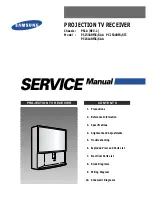
BE1-951
Application
8-35
De-energizing IN4 or closing virtual switch 343 places the logic scheme in test mode. IN4 can be controlled
by a panel mounted selector switch that is closed in the normal state and open in the test state. IN4 can also
be controlled by a pole of a standard external test switch that is opened with the rest of the test switch poles.
When test mode is activated in the BUS relay, external breaker failure initiate (BFI) via VO3 is inhibited. The
BACKUP relay will block its own breaker failure function while test mode is enabled.
The logic for test mode drives VO15 which drives alarm bit 23 in the programmable alarm mask. Alarm bit
23 can be masked to drive an alarm LED and HMI alarm display screen to provide indication when the relay
is in test mode.
Contingency Operation - Backup Protection for Bus Breaker Failure
Bus breaker-failure protection is provided by the main bus relay using the preprogrammed logic scheme
BACKUP. OUT5 is configured as the breaker failure trip output. OUT5 can be wired to trip the upstream
breaker, a bus breaker-failure lockout relay, or other lockout relays that trip the transformer high side such
as the 86T transformer differential lockout relay.
Provision for external breaker failure initiation (BFI) is accommodated by IN3 of the BACKUP relay. The
150T function blocks provide fault detector supervision of IN3. The BACKUP logic scheme uses the pickup
outputs of the 150TP/N/Q function blocks to drive the initiate input of the breaker failure function block. A
maximum time delay setting for the 150TP/N/Q function blocks is needed to ensure that they don’t trip and
target. The breaker failure function block is also initiated by a protective trip (VO11). Keep in mind, if you are
tripping for a bus fault via a lockout relay, the additional time delay of the lockout relay should be added to
your breaker failure time delay setting.
The breaker failure function block has an independent fast dropout phase current detector that senses a
breaker opening and stops timing. An open breaker is detected when the current drops below 10 percent
of the nominal CT input (1 A or 5 A) for the relay.
A time delay setting of zero disables the BF function block. This permits the traditional radial system backup
scheme of coordinated relays tripping different breakers.
Contingency Operation - Backup Protection for BACKUP Relay Out of Service
When the BACKUP relay is out of service, full high-speed bus fault protection and overload protection are
provided by the BUS relay. Breaker failure protection is not provided during this double-contingency
situation.
Contingency Operation - Backup Protection for Feeder Relay Out of Service
OUT3 of each feeder relay should be wired to an auxiliary transfer relay (83/Fn) with one normally open and
one normally closed contact. Under normal conditions, OUT3 of a feeder relay is closed and the 83 auxiliary
relay is picked up. When a relay is in test mode and out of service or withdrawn from its case, the 83
auxiliary relay will drop out.
The normally open contact (NO in shelf state) of the 83/Fn auxiliary relay is wired to IN2 of the BACKUP
relay to signal the BUS and BACKUP relays to change to setting group 1. When setting group 1 is active,
the BUS relay 50T and 51 overcurrent function blocks trip an auxiliary tripping relay (94/BU) via OUT5.
In setting group 1, the BACKUP relay 51 time settings must coordinate with the BUS relay 51 time dial
settings. Since the feeder relays provide a blocking signal to the BUS relay upon pickup of the 51 function
blocks, it isn’t necessary for the 51 time dial settings of the BUS relay to coordinate with the feeder relays
in setting group 1. Therefore, the 51 time dial settings of the BUS relay can be reduced in setting group 1
to provide the necessary coordination interval between the BUS relay and the BACKUP relay for this
contingency. This minimizes the time delay that needs to be added to the BACKUP relay time dial settings
and provides a greater opportunity to keep the setting below the transformer damage curve.
The tripping output of the 94/BU auxiliary relay and the normally closed contacts (form B) of the 83/Fn
auxiliary relay are wired in series with the feeder breaker trip coil. This allows the 94/BU relay to trip the
feeder breaker when the feeder relay is out of service.
When the BUS and BACKUP relays are in feeder relay backup mode, relay responses to the various faults
















































